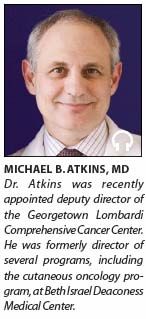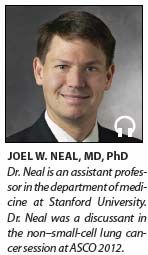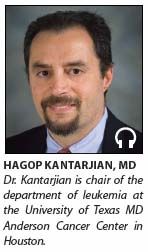ASCO Reports: Highlights from Exclusive Oncology Interviews
The primary endpoint of progression-free survival was met, and the absolute improvement in median progression-free survival was about 3.2 months.

Dr. Kimberly Blackwell on the results of the EMILIA trial
The primary endpoint of progression-free survival was met, and the absolute improvement in median progression-free survival was about 3.2 months. Now that in itself is always very exciting. . . . I think anytime we see a treatment option that improves outcome, people’s ears perk up and we all start thinking about when the drug becomes available, how we are going to use it. Probably the second most exciting finding in the EMILIA study was that the drug, which is a traditional cytotoxic known as DM1 and bound to trastuzumab, has very little toxicity associated with impact on quality of life and other measures such as grade 3 or greater adverse events. And this is a real proof-of-principle study in that it showed that if you can link a cytotoxin to an antibody and deliver it directly to the cancer cell, then the side effect profile will be quite favorable. We saw an 18% absolute difference in treatment discontinuation due to adverse events. It was higher in the control arm compared to the T-DM1 arm. . . . People are excited, even if they don’t take care of a lot of breast cancer patients, because of the proof of concept that maybe we could lessen the toxicity of chemotherapy by binding it to a tumor-directed antibody

Dr. Michael Atkins on new research in metastatic melanoma
How might targeting PD1 be different from targeting CTLA-4, and what might be the advantage (if any)?
“CTLA-4 is a very early checkpoint inhibitor, and when you target it, the interaction is likely blocking an interaction between antigen-presenting cells and immune cells that takes place in a lymph node, and therefore the effects are not selective to the tumor and you can release immunity not just against tumor antigens but against host antigens. The blocking of PD1 or the PD1 ligand (PDL1) appears to take place more peripherally because PDL1 and PD1 only seem to interact in peripheral tissues, and so providing an antibody that blocks that interaction might limit the effects to the tumor site. So that means that there's potential for more selectivity and less toxicity.”
What progress has been made in melanoma with regard to the problem of patients developing
resistance to targeted agents such as vemurafenib and dabrafenib?
“There was a very nice oral presentation from a group led by Jeff Sosman . . . that looked at analysis of tumor specimens pre- and at-time-of resistance in a number of patients receiving vemurafenib. And their conclusion was that the majority of resistance mechanisms involved reactivation of the MAP kinase pathway and specifically phospho-ERK, and they reported a number of mechanisms by which that can happen . . . but what they also mentioned were the frequency of mutations in NRAS and in MEK that were seen in their population. Some of those mutations were bypassed pathways that may be sensitive to MEK inhibitors-but not all of them-and therefore one of the proposals for prolonging the benefit to selective RAF inhibitors could be to combine them with a MEK inhibitor, and there was some data presented in the MEK inhibitor session that suggested that a combination of a RAF inhibitor and MEK inhibitor was tolerable and may produce a longer progression-free survival-although once again, resistance does develop.”

Dr. Joel Neal on new developments in the treatment of non–small-cell lung cancer
“For the community oncologists, the biggest finding is probably the overall survival analysis of the PARAMOUNT trial. This trial . . . showed that maintenance pemetrexed, after induction cisplatin/pemetrexed had an overall survival benefit, in addition to the progression-free survival response that we saw earlier. . . . So there is some evidence to say that continuation maintenance of pemetrexed, in addition to switch maintenance pemetrexed, which is already FDA-approved, may be useful.
One of the most exciting results I think we saw was from Julie Brahmer, about the PD-1 drug. . . . In a phase I trial including about 100 non–small-cell lung cancer (NSCLC) patients, they saw a response rate of about 18% in heavily pretreated patients, and some of those responses lasted for more than 24 weeks. The drug had fairly low side effects-just a little rash, diarrhea, fatigue, and itching-because it’s an immunotherapy, so really this shows us that moderating the immune system may be a potential target in NSCLC.”

Dr. Hagop Kantarjian on the latest data on CML
“There were updates of the two front-line randomized studies looking at the second-generation TKIs, nilotinib and dasatinib vs the standard of care, which is imatinib. And in both of these updates the investigators report that the second-generation TKIs continue to show an advantage in terms of the early surrogate endpoints. . . . I think the more important study is the one with ponatinib, which is also a BCR-ABL tyrosine kinase inhibitor, but in contrast to the other two drugs, it is also active against the T315I mutation, which other drugs have not been effective against. . . . the results with ponatinib are very, very impressive. What was seen in the chronic phase, for example, is a complete cytogenetic response rate of 44%, a major cytogenetic response rate of 54%, and a major molecular response rate of 30%. And those responses were durable. With a follow-up of about 10 months, 93% of the major cytogenetic responses were continuing to be there. . . . This drug is also highly effective against the T315I mutation.
There were 64 patients with the T315I mutation in chronic phase, and among them the complete cytogenetic response rate was 66%, the major cytogenetic response rate was 70%, and the major molecular response rate was 50%, which is very exciting data. We believe that this information may evolve into FDA approval of this drug for patients with refractory disease to at least two TKIs, as well as in patients with the T315I mutation.”